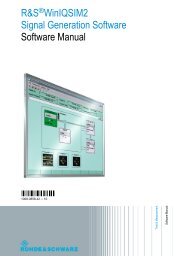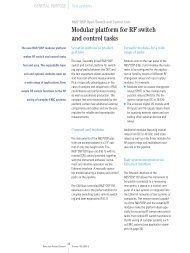Application Note SCPI Recorder - Rohde & Schwarz Singapore
Application Note SCPI Recorder - Rohde & Schwarz Singapore
Application Note SCPI Recorder - Rohde & Schwarz Singapore
You also want an ePaper? Increase the reach of your titles
YUMPU automatically turns print PDFs into web optimized ePapers that Google loves.
Introduction<br />
History of Test Automation<br />
1 Introduction<br />
1.1 History of Test Automation<br />
With the growing use of remote controlled test equipment and test systems in the<br />
industry in the 1980s it became evident that the required control software would<br />
substantially increase the total costs of the test systems. It was recognized that the<br />
proprietary software interface in between the controller and the test instrument which<br />
often even differed amongst the devices of one manufacturer, mainly influenced the<br />
development and service efforts and consequently the costs of the test solution.<br />
In order to overcome this, the Standard Commands for Programmable Instrumentation<br />
(<strong>SCPI</strong>) consortium specified a software interface language and adopted it as part of the<br />
IEEE-488.2 (GBIP) standard in 1990 [6]. During the following years <strong>SCPI</strong> was<br />
increasingly accepted in the market and therefore was specified for additional test<br />
interfaces. Today <strong>SCPI</strong> is available for GPIB, RS-232, VXIbus, Ethernet LANs, and<br />
USB. <strong>SCPI</strong> is not only almost independent from the hardware, but is also supported by<br />
all common programming languages and Integrated Development Environments (IDE)<br />
used for test automation software development.<br />
<strong>SCPI</strong> encompasses both ‘common commands’ supported by all <strong>SCPI</strong> compatible<br />
devices and ‘instrument control commands’ that are in line with the <strong>SCPI</strong> syntax but<br />
are defined manufacturer- and/or device-specific.<br />
The original advantage of <strong>SCPI</strong>, its ASCII based syntax, eventually slowed down the<br />
development of test software as the test devices became more and more complex and<br />
the number of command sequences grew nearly exponentially (e.g. >5000 commands<br />
for a high-end vector signal generator).<br />
Each command required to trigger a certain reaction of the device first had to be<br />
selected from the programming manual of the respective device. In a second step it<br />
had to be transferred without any support from the IDE in use, into the respective<br />
programming language applying the correct syntax and semantics.<br />
In 2001, the IVI foundation was established in order to resolve this problem. Both<br />
manufacturers for test- and measurement equipment, software, and test systems, and<br />
test system integrators and also end users are members of the foundation. R&S is one<br />
of the three sponsor members of the foundation and is actively contributing to the<br />
standardisation process. Since 2003, the <strong>SCPI</strong> consortium has been integrated into the<br />
IVI foundation as well.<br />
The foundation’s objective is to develop a specification of a driver-based software<br />
interface that supports the interchange ability of test devices independent of the<br />
manufacturer. In addition, the implemented driver functionality (simulation mode, range<br />
check, state caching, auto complete) shall significantly reduce the development and<br />
service costs for remote control applications.<br />
Like R&S, all other main manufacturers of test instruments have now come to offer socalled<br />
IVI drivers. Therefore it is now possible to exchange devices belonging to one of<br />
the currently defined 13 device classes (e.g. RF signal generator: IviRFSigGen class)<br />
independently of the manufacturer, if<br />
only IVI class drivers with base class capabilities are used and<br />
all used / required functions of the device are realised in the respective driver<br />
1GP98_0E <strong>Rohde</strong> & <strong>Schwarz</strong> <strong>SCPI</strong>-<strong>Recorder</strong> 5

















